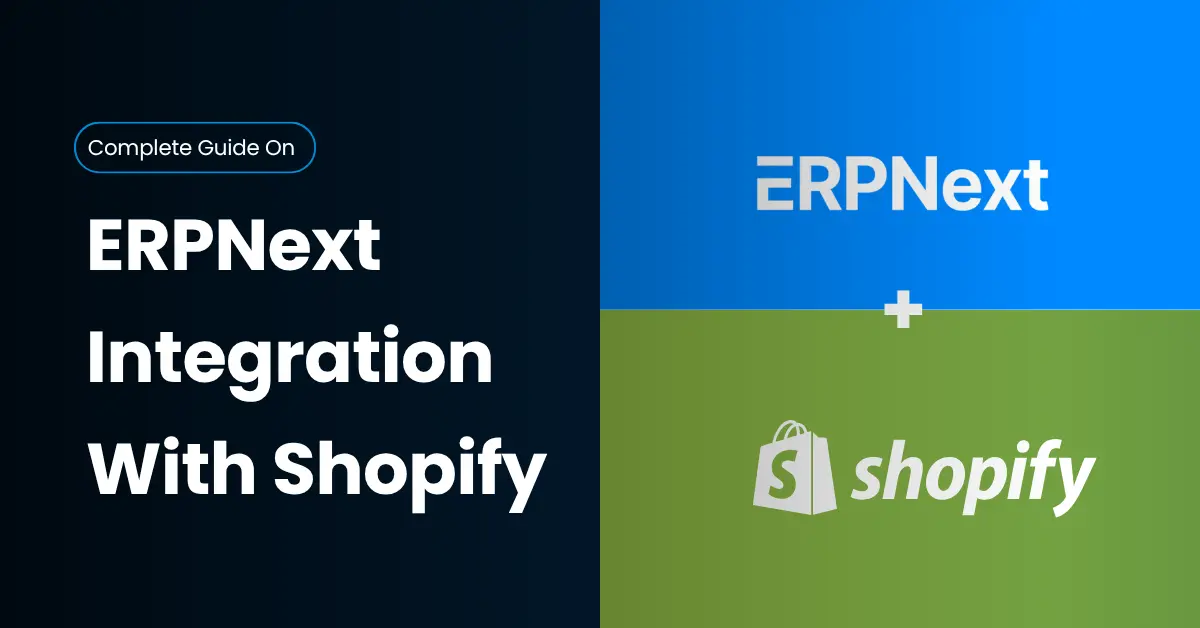In 2025, almost every e-commerce business's success depends on communication between its departments and sectors. Every retail business that manages a Shopify store without integrating the ERPNext system often makes errors and requires double-checking — whether it's manual order updates, inventory mismatches, or delayed reports. This wastes a lot of time and impacts business growth.
That’s why more businesses are moving to Shopify integration with ERPNext. When both systems sync in real time, every sale, shipment, and payment is automatically recorded across departments. It’s not just an IT upgrade — it’s a smarter way to run your operations.
In this step-by-step guide, we wil explore how to connect ERPNext with Shopify, what data syncs between them, and how to ensure the best automated workflow for your growing business.
Understanding Shopify and ERPNext Integration
Shopify is your customer-facing storefront — managing product listings, payments, and online orders. ERPNext, built on the Frappe framework, handles your back office: accounting, inventory, procurement, and reporting. Integration bridges these two worlds.
When done correctly, Shopify–ERPNext integration eliminates repetitive manual data entry and provides a unified view of your business. Orders, customers, and stock levels flow seamlessly between systems, so your team can focus on fulfillment and strategy — not spreadsheets.
Why Integration Matters for Modern eCommerce
Disconnected systems create blind spots. For example, a customer might buy the last unit online while your warehouse still shows it as available — leading to frustrated customers and refund requests. Integration prevents that.
With real-time data synchronization, every transaction updates automatically in both platforms. This means you get accurate inventory control, faster order fulfillment, and clearer financial reporting — all in one ecosystem.
Key Benefits of Integrating Shopify with ERPNext
When you connect Shopify to ERPNext, the benefits go beyond convenience. You create an intelligent workflow that scales with your business. Whether you’re running one store or multiple sales channels, integration helps you maintain control without increasing workload.
Real-Time Inventory and Order Management
- Automatically sync stock levels between Shopify and ERPNext.
- Eliminate overselling and backorders.
- Centralize order fulfillment and shipping updates.
- Cut down manual reconciliation across systems.
For example, if a product sells on Shopify, ERPNext immediately updates stock levels and creates a linked sales order, ensuring warehouse teams always work with accurate data.
Smarter Financial and Customer Insights
When your Shopify transactions flow into ERPNext automatically, your financial data becomes clearer. You can track sales, costs, and profitability in real time — without waiting for end-of-day reports.
ERPNext also consolidates customer information, giving sales and service teams better visibility into order history and preferences. Over time, this data helps refine pricing strategies and improve retention.
Step-by-Step Guide to Integrating Shopify with ERPNext
Integration might sound complex, but with a structured approach, it’s entirely manageable — even for small teams. The key is understanding what’s required before setup and following each configuration step carefully.
Prerequisites Before Setup
Before you begin, make sure you have the following:
- Updated versions of Shopify and ERPNext (v15 or higher recommended).
- Admin access to both systems.
- API keys and credentials from Shopify’s admin panel.
- A list of data types you plan to synchronize — products, orders, customers, and inventory levels.
- Access to the Shopify App Store (if using a third-party ERPNext connector).
Having these ready prevents delays during configuration and reduces errors later.
Connecting Shopify with ERPNext
Follow these steps to create a stable integration between both platforms:
- Install the Shopify Connector from ERPNext’s Integrations module.
- Navigate to ERPNext Settings → Integrations → Shopify.
- In Shopify, go to Apps → Manage Private Apps → Create API Credentials.
- Copy your API keys and Webhook URLs into ERPNext.
- Configure synchronization settings — choose what data (products, orders, customers) to sync and how often.
- Test the connection and confirm data mapping accuracy.
This ensures bidirectional synchronization between Shopify and ERPNext, so both platforms share the same inventory and order information in real time.
Testing and Validation
Once configured, run a test transaction in Shopify — create an order and check if it appears in ERPNext automatically. Verify that SKU codes, pricing, and customer details match exactly.
This validation step is critical. It confirms that your API endpoints, webhooks, and data mappings are working correctly before you go live.
What Data Can Be Synchronized Between Shopify and ERPNext
A strong integration doesn’t just connect two systems — it aligns your entire business workflow. The Shopify–ERPNext sync allows you to automate multiple data streams simultaneously, ensuring every department works from the same, accurate dataset.
Here’s what you can synchronize:
1. Product and Inventory Data
Every product in Shopify — including SKUs, descriptions, and pricing — can sync directly to ERPNext’s Item Master. When you add or update a product in one system, the change reflects in the other automatically.
Inventory levels are also updated in real time. If you sell five units on Shopify, ERPNext immediately deducts them from available stock, keeping your warehouse accurate and your online store honest.
2. Customer Data
When a customer places an order in Shopify, their contact and shipping details are automatically added to ERPNext’s Customer database. This creates a unified customer profile that supports better support, repeat sales, and analytics.
3. Orders and Payments
Shopify orders convert into Sales Orders or Sales Invoices in ERPNext. Payment information flows along, allowing your finance team to track every transaction accurately without manual entry.
4. Shipping and Fulfillment
You can integrate ERPNext’s logistics module to update shipment statuses automatically. When a package is marked as shipped in ERPNext, the status can be reflected back on Shopify — ensuring customers receive real-time updates.
Common Integration Challenges and How to Overcome Them
Even the most well-planned integrations can face hiccups. Understanding these early helps prevent downtime and frustration later.
1. Data Mapping Inconsistencies
Sometimes, Shopify and ERPNext use different field names (for example, “SKU” in Shopify vs “Item Code” in ERPNext). Incorrect mapping can cause missing or duplicated entries.
Solution: Double-check field mappings before going live, and run test syncs for validation.
2. API Limits or Version Conflicts
Shopify has API rate limits that may delay synchronization during high sales volume.
Solution: Schedule sync intervals smartly and keep both systems updated to the latest versions.
3. Duplicate Records or Missing Data
When integrations are configured incorrectly, duplicate customers or incomplete orders can appear in ERPNext.
Solution: Use ERPNext’s built-in data merge and cleanup tools, and ensure only one direction of data creation is active per module (e.g., create products in ERPNext, not Shopify).
Best Practices for a Smooth Shopify–ERPNext Integration
For long-term stability and accuracy, follow these implementation best practices:
- Plan Your Data Flow: Decide which system will be the “master” for specific data types — for example, inventory in ERPNext and product descriptions in Shopify.
- Test Incrementally: Sync one module at a time (e.g., products first, then orders).
- Monitor Webhooks: Set up alerts to monitor synchronization failures or API downtime.
- Train Your Team: Ensure your staff understands where updates should be made post-integration.
- Schedule Regular Backups: Always keep data backups before syncing large volumes of records.
How Infintrix Technologies Helps Businesses Simplify Integration
While ERPNext offers built-in tools for Shopify integration, achieving a stable, enterprise-grade connection often requires technical alignment and optimization.
That’s where Infintrix Technologies brings value.
As an experienced ERPNext implementation partner, Infintrix helps businesses design seamless Shopify–ERPNext integrations — from planning and API configuration to testing and post-launch monitoring.
Their consultants ensure that your workflows aren’t just connected — they’re optimized for performance, security, and scalability. Whether you’re an SME or a growing eCommerce brand, professional guidance can make the difference between a smooth rollout and recurring sync issues.
Conclusion
Integrating Shopify with ERPNext transforms how your business operates — reducing manual work, improving accuracy, and giving you real-time visibility across sales, finance, and inventory.
When executed strategically, this integration creates an efficient digital ecosystem where every process is connected.
And if you prefer expert guidance, Infintrix Technologies offers tailored ERPNext integration services to help you go live confidently — with a setup that scales as your business grows.
FAQs
1. Is the Shopify–ERPNext integration free?
ERPNext includes a basic Shopify connector, but advanced customization or multi-store setups may require paid development or third-party apps.
2. Can I choose what data to sync between systems?
Yes. You can select specific modules such as products, customers, orders, and payments based on your workflow needs.
3. How long does integration usually take?
A basic setup can be completed in 1–2 days, while a customized integration with workflow automation may take 1–2 weeks.
4. What if I need technical assistance during integration?
You can consult experts like Infintrix Technologies, who specialize in ERPNext and can handle the entire process — from setup to troubleshooting.

